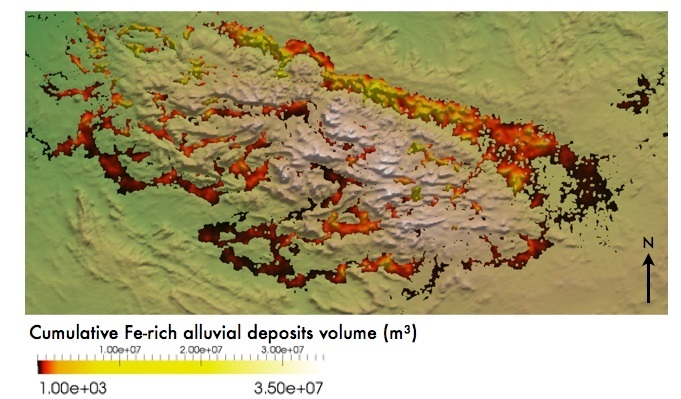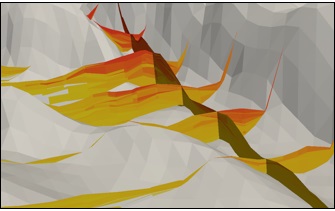By Emily Lehmann
Iron rich material in the deposit: The orange showing areas with the highest percentage of iron.
We’ve created our very own time machine – a new modelling tool that can simulate millions of years of landscape evolution and possibly reveal hidden treasures.
Using the tool called LECODE, and iVEC’s supercomputer, our scientists travelled back in time to pinpoint the exact moment when deposits formed in the iron-rich Hamersley province in Western Australia.
The study has revealed potential locations for hidden and unexplored iron ore deposits.
“We simulated how erosion and water flow influenced the transport of sediment over thousands to millions of years, showing how the iron-rich soils were carried from one place to another to build sedimentary deposits,” says researcher Dr Guillaume Duclaux.
“Sedimentary (aka alluvial) deposits at the Earth’s surface can host significant mineral resources, however exploring them is challenging because they are built from layers of transported material that effectively hide the mineral deposits within,” he says.
“By exploring the material’s movement from the hill slopes to the valleys, we can predict the location of larger deposits hosted underground.”
There’s a high economic value attached to sedimentary iron deposits, which provide 40 per cent of Australia’s iron ore exports.
“Geologists and explorers could use the tool to make new mineral discoveries and it will reduce exploration costs and the environmental impacts associated with traditional drilling techniques,” Dr Duclaux says.
“This research has brought up new questions around the processes that trigger the formation of this type of deposit, which we’re investigating next,” he says.

Our tool is a 3D modelling code tailored to solve problems related to basin and landscape evolution. It could also be applied to other resources, such as gold and petroleum.
Dr Duclaux, Dr Tristan Salles and Dr Erick Ramanaidou presented this work at the AusIMM Iron Ore 2013 conference last week.
Learn more about CSIRO’s research in mineral exploration.



22nd August 2013 at 11:55 am
Smart bastards we certianly have a great bunch of cleaver people at CSIRO could it also be used to dectect historic settlements or fossile deposits. In other words priour to extraction aborigional oor other ancient cultural sites and fossile bed could be detected giving us even greater areas for research. Also educing conflicts of intrests. So lets not just give this ovet to the mining giants lets use it for the overall betterment of humanitywhich is part of your charter. This is science. Peter Ward